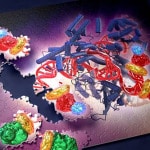
When I last wrote about AI on this blog three years ago, I spoke of it being a tool with the potential to transform scientific discovery, but the application I described was primarily theoretical. For AI to be a meaningful tool in R&D, I argued, we needed better sources of “truth” – better data sets that AI tools could query and learn from over time – and technology capable of integrating multiple steps into a semi-automated system. My message was that AI-enabled drug discovery was coming…someday.
Fast forward to 2025, and that someday is now.
We’ve seen an explosion in the availability and capability of AI tools. Just 10 months after I wrote about the theoretical possibilities of AI in biopharma, OpenAI debuted ChatGPT. Shortly after that, we saw the rollout of Microsoft Copilot and Meta AI. We now have immense computational power at our fingertips, with programs specifically designed to query biological problems. Combined with the ingenuity of skilled scientists, who can define the research problem and generate curated datasets that will enable solutions, AI has become an important and practical tool that is helping researchers accelerate discovery (link to Google DeepMind podcast on this topic here; link to a start-up’s pragmatic journey of AI in drug discovery here).…
Read full article...

[ I am an employee of Bristol Myers Squibb. The views expressed here are my own, assuming I am real and not a humanoid. ]
In the original Blade Runner (1982), Harrison Ford’s character, Deckard, implements a fictitious Voight-Kampff test to measure bodily functions such as heart rate and pupillary dilation in response to emotionally provocative questions. The purpose: to establish “truth”, i.e., determine whether an individual is a human or a bioengineered humanoid known as a replicant.
While the Voight-Kampff test was used to establish truth for humans vs replicants, the concept of “truth” is central to neural networks used in machine learning and artificial intelligence (AI). And for AI to be effective in drug discovery and development, it is critical to ask a fundamental question: what is “truth” in drug discovery and development?
INTRODUCTION
I recently read the book Genius Makers by Cade Metz and was reminded of the long history of machine learning, neural networks, and artificial intelligence (AI). This is a field more than 60 years in the making, with slow growth for the first 50 years – AI was founded as an academic discipline in 1956 – and exponential growth in the last 10. The original mathematical framework of neural networks was created in the 50’s (perceptron), 60’s and 70’s (backpropagation), but went largely unappreciated outside of academics, as the practical applications were few and far between.…
Read full article...

[I am an employee of BMS. The views expressed here are my own.]
The blog is long, so I will start with an executive summary. (You can download a pdf copy of the blog here.) Pharmacologic intervention has the opportunity to impact disease progression in the SARS-CoV-2 / COVID-19 crisis. Repurposing of approved therapies is the fastest way to impact patients today, as these medicines have regulatory approval to enable investigator-initiated trials and have a manufacturing process to ensure drug supply. Here, I focus on a specific clinical inflection point in COVID-19 disease progression – hospitalized patients early in their disease course and with signs of a maladaptive immune response, with the intervention intended to prevent disease progression and admission to the ICU. Based on an understanding of disease biology today – which is still quite limited – this clinical inflection point is due to a “maladaptive immune response” seen early in the disease course in patients who later progress to critical illness. Rigorous clinical trials are required to test therapeutic hypotheses related to repurposed therapies, which need to be done in a clinical setting caring for extremely sick patients. Finally, I describe additional research that is required to understand the biology of SARS-CoV-2 / COVID-19, and how such research (e.g.,…
Read full article...

[Disclaimer: I am an employee of Celgene. The views reported here are my own.]
I recently participated in a Harvard Medical School Executive Education course on human genetics and drug discovery (link here, slides here and here). My presentation concluded with a short discussion on emerging resources such as Phenome-Wide Association Studies (PheWAS) to predict adverse drug events and guide indication selection, and protein quantitative trait loci (pQTLs) for Mendelian randomization. In this blog, I highlight briefly our recent Nature publication on pQTLs, “Genomic atlas of the human plasma proteome” (here), which represents a new public resource for drug discovery.
Human genetic targets are endowed with favorable properties, one of which is the ability to use genetic tools for nature’s randomized control trial. Central to this concept is Mendelian randomization, a method that uses human genetic variants as an instrument to examine the causal effect of a modifiable exposure (e.g., protein biomarker) on disease in observational studies (reviewed here and recent Nature Reviews Genetics here).
Proteins provide an ideal paradigm for Mendelian randomization analysis for drug discovery, as proteins are under proximal genetic control and represent the targets of most approved drugs.…
Read full article...

As readers of my blog know, I am a strong supporter of a disciplined R&D model that focuses on: picking targets based on causal human biology (e.g., genetics); developing molecules that therapeutically recapitulate causal human biology; deploying pharmacodynamic biomarkers that also recapitulate causal human biology; and conducting small clinical proof-of-concept studies to quickly test therapeutic hypotheses (see Figure below). As such, I am constantly on the look-out for literature or news reports to support / refute this model. Each week, I cryptically tweet these reports, and occasionally – like this week – I have the time and energy to write-up the reports in a coherent framework.
Of course, this model is not so easy to follow in the real-world as has been pointed out nicely by Derek Lowe and others (see here). A nice blog this week by Keith Robison (Warp Drive Bio) highlights why drug R&D is so hard.
Here are the studies or news reports from this week that support this model.
(1) Picking targets based on causal human biology: I am a proponent of an “allelic series” model for target identification. Here are a couple of published reports that fit with this model.…
Read full article...

I have many fears, both professional and personal. When I decided to leave academics for a job in industry in 2013, my biggest fear about making the transition was scientific. In my mind, I had a model of how human genetics might transform drug discovery and development. There were anecdotes (e.g., PCSK9 inhibitors) and a few systematic studies in specific diseases (e.g., genetics of rheumatoid arthritis), but there were many holes to the model. Over the last couple of years, additional anecdotes and systematic analyses have emerged (e.g., Matt Nelson, et al. Nature Genetics), which helps to soothe my fears…but I still have concerns.
[Disclaimer: I am a Merck/MSD employee. The opinions I am expressing are my own and do not necessarily represent the position of my employer.]
As I have blogged about previously, I see two primary routes to go from human genetics to new drug discovery programs (see here, here). The first requires that there are genes with a series of disease-associated alleles with a range of biological effects, ideally from gain- to loss-of-function (allelic series model). The second requires disease-associated genes to aggregate within specific biological pathways, which can then be turned into assays for disease-relevant pathway-based screens such as phenotypic screens.…
Read full article...

A study published last week in Science described a large-scale genetic association study of Neandertal-derived alleles with clinical phenotypes from electronic health records (EHRs). Here, I focus less on the Neandertal aspect of the study – which to me is really just a gimmick and not medically relevant – and more on the ability to use EHR data for unbiased association studies against a large number of clinical traits captured in real-world datasets. I also provide some thoughts on how this same approach could be used for drug discovery.
[Disclaimer: I am a Merck/MSD employee. The opinions I am expressing are my own and do not necessarily represent the position of my employer.]
The study used clinical data from the Electronic Medical Records and Genomics (eMERGE) Network, a consortium that unites EHR systems linked to patient genetic data from nine sites across the United States. The clinical data was primarily from ICD9 billing codes, an imperfect but decent way to capture clinical data from EHRs. In total, a set of 28,416 adults of European ancestry from across the eMERGE sites had both genotype data and sufficient EHR data to define clinical phenotypes (n=13,686 in the Discovery set; n=14,730 in the replication set).…
Read full article...

Recently I was asked by the American Society of Human Genetics (ASHG) to provide my perspective on career and professional development in genetics (see here). At about the same time, I read the book “How Google Works”, by Google Executive Chairman and ex-CEO Eric Schmidt and former SVP of Products Jonathan Rosenberg. A very creative slide deck accompanies the book, which is definitely worth a few minutes of your time (here).
Both got me thinking about opportunities in the pharmaceutical industry for genetic graduate students. Here are a few thoughts based on the outline from the Google slide deck.
What is different now?
In human genetics, large-scale genotyping and sequencing is unlocking the inherited basis of most complex and rare traits in the ideal model organism, humans. This is very different than it was just a few years ago. But there is more: this is happening at a scale that will not likely stop until most humans on the planet have their genome sequenced. Like the “Internet of things”, there will soon be a “Genomes of things”, in which our genomes will be connected to all sorts of data – electronic health records, wearable technology, portable blood monitoring, etc.…
Read full article...

This week’s theme is genes to function for drug screens…with a macabre theme of zombies! As more genes are discovered through GWAS and large-scale sequencing in humans, there is a pressing need to understand function. There are at least two steps: (1) fine-mapping the most likely causal genes and causal variants; and (2) functional interrogation of causal genes and causal variants to move towards a better understanding of causal human biology for drug screens (“from genes to screens”).
Genome-editing represents one very powerful tool, and the latest article from the laboratory of Feng Zhang at the Broad Institute takes genome-editing to a new level (see Genetic Engineering & Biotechnology News commentary here). They engineer the dead!
Genome-scale gene activation by an engineered CRISPR-Cas9 complex, Nature (December 2014).
Since its introduction in late 2012, the CRISPR-Cas9 gene-editing technology has revolutionized the ways scientists can apply to interrogate gene functions. Using a catalytically inactive Cas9 protein (dead Cas9, dCas9) tethered to an engineered single-guide RNA (sgRNA) molecule, the authors demonstrated the ability to conduct robust gain-of-function genetic screens through programmable, targeted gene activation.
Earlier this year, the laboratories of Stanley Qi, Jonathan Weissman and others \ reported the use of dCas9 conjugated with a transcriptional activator for gene activation (see Cell paper here).…
Read full article...

I have come across three reports in the last few days that help me think about the question: How many genomes is enough? My conclusion – we need a lot! Here are some thoughts and objective data that support this conclusion.
(1) Clinical sequencing for rare disease – JAMA reported compelling evidence that exome sequencing identified a molecular diagnosis for patients (Editorial here). One study investigated 2000 consecutive patients who had exome sequencing at one academic medical center over 2 years (here). Another study investigated 814 consecutive pediatric patients over 2.5 years (here). Both groups report that ~25% of patients were “solved” by exome sequencing. All patients had a rare clinical presentation that strongly suggested a genetic etiology.
(2) Inactivating NPC1L1 mutations protect from coronary heart diease – NEJM reported an exome sequencing study in ~22,000 case-control samples to search for coronary heart disease (CHD) genes, with follow-up of a specific inactivating mutation (p.Arg406X in the gene NPC1L1) in ~91,000 case-control samples (here). The data suggest that naturally occurring mutations that disrupt NPC1L1 function are associated with reduced LDL cholesterol levels and reduced risk of CHD. The statistics were not overwhelming despite the large sample size (P=0.008, OR=0.47). …
Read full article...

In my previous blog series I talked about why genetics is important in drug discovery: human genetics takes you to a target, informs on mechanism of action (MOA) for therapeutic perturbation, provides guidance for pre-clinical assays of target engagement, and facilitates indication selection for clinical trials.
Here, I provide an overview of a new blog series on how genetics influences decision-making during drug discovery. The key principle: human genetics establishes a disciplined mindset and a firm foundation – anchoring points – for advancing targets through the complicated process of drug discovery. [For those less familiar with drug discovery, the end of this blog provides a brief primer on the stages of drug discovery.]
I highlight three areas: establishing a balanced portfolio, identifying targets with novel MOA, and creating a framework for objective decision-making. In subsequent posts, I will focus primarily on how human genetics informs on the latter (decision-making), with blogs pertaining to designing assays for screens and target engagement, utilizing pre-clinical animal models, predicting on-target adverse drug events, and selecting indications for clinical trials.
1. Establish a balanced portfolio
Whether in academic research, a small biotech company (see here) or a large pharmaceutical company (such as Merck, where I work), a balanced portfolio of projects is very important.…
Read full article...

A key learning from my time in academia was the value of collaborations. Much of my most enjoyable and productive research was conducted in collaboration with fellow scientists across the globe.
I am pleased to report that industry is no different. After one year working for Merck, I have found that in addition to collaborations across the company ties with external scientific experts focused on advancing programs of interest are actively encouraged.
It is heartening to see how some recent progress in several notable drug development programs is leading to increased excitement around the application of human genetics in identifying human drug targets. As I have previously noted, human genetics can also provide insights to identifying pathways enriched for approved drugs (see Nature article here), which indicates that novel pathways may provide an important foundation for novel drug discovery programs. Indeed, the use of pathway-based approaches, including phenotypic screens, can provide a powerful way to make complex genetic pathways actionable for drug discovery.
Today, I am excited to note that Merck has launched a Merck Innovation Network (MINt) Request for Proposals to identify collaborations with academic scientists to evaluate genetic targets or genetic pathways for their potential to become drug discovery programs. …
Read full article...













